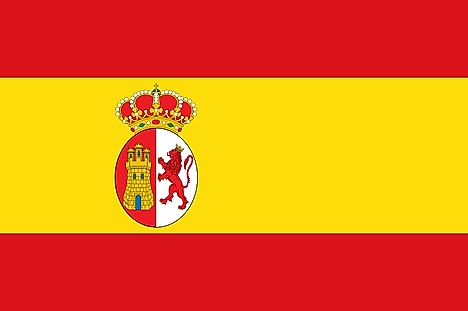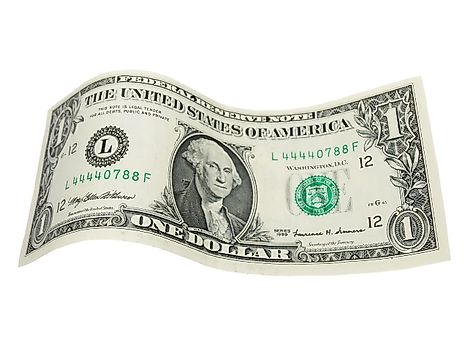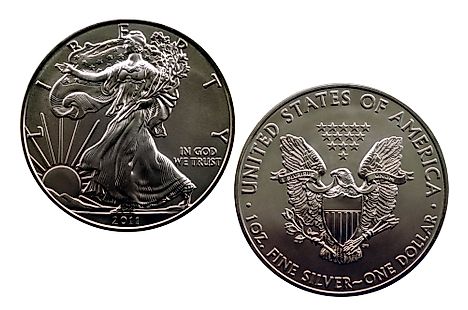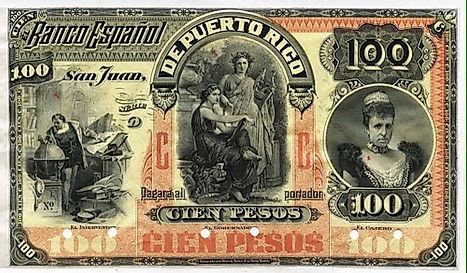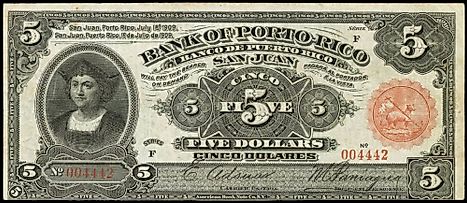Flags, Symbols & Currency of Puerto Rico
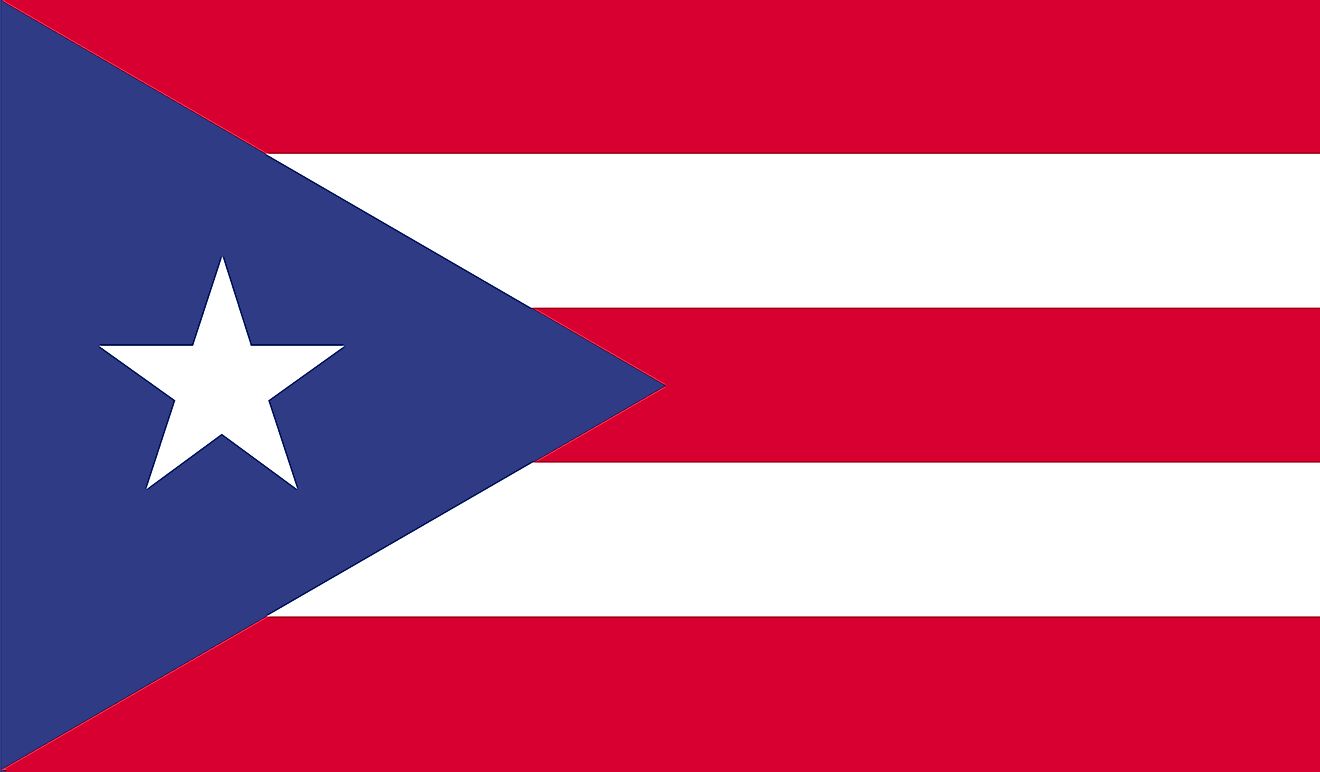
The National Flag of Puerto Rico was officially adopted on July 25, 1952, under the rule of Governor Luis Marín. Several Puerto Ricans are credited with the creation of the design although most sources attribute the flag design to Francisco Marín.
The National Flag of Puerto Rico features five equal horizontal bands of red (top, center, and bottom) alternating with white. A blue isosceles triangle based on the hoist side bears a large, white, five-pointed star in the center. The red color stands for the bloodshed by brave Puerto Ricans in their quest for freedom. The white color stands for the Puerto Rican triumph in their quest for independence as well as the peace they hoped to attain. It also represents individual liberty and the rights that keep the government in balance. The blue triangle on the flag's hoist side stands for the "Republican Government", where its three sides signify the three branches - executive, legislative and judicial parts of the government. The triangle contains a white five-pointed star to signify the Puerto Rican territory and hence represent "The Commonwealth of Puerto Rico." The blue color represents the sky and the ocean. The flag has a width-to-length proportion ratio of 2:3.
History of the flag of Puerto Rico
The first time a flag was used in Puerto Rico’s territory was when Christopher Columbus arrived in the region and hoisted the Spanish Royal Flag. Flags were also flown continuously during the Spanish conquest of the area as Juan León's forces flew the Spanish Expedition Flag. From 1492 onwards, when the entirety of Puerto Rico fell under Spanish control, the Spanish government hoisted their national flag in the territory. Flags were also vital to the native Puerto Ricans who agitated for independence with notable leaders like, Ramón Emeterio, who in 1868, conceived the importance of an original flag. Mariana Bracetti, drawing inspiration from the Dominican flag, designed and knit a flag that was used during the revolution. The Puerto Rican Revolutionary Committee used the flag in their quest to liberate Puerto Rico on March 24, 1897. When Puerto Rico became an American territory, the Puerto Rican flag was outlawed from 1898 -1952. When the flag was formally adopted, the symbolism behind some of the colors was altered to distance the flag from its history. The meaning behind the white bars was changed to represent the new republican system of government while the blue was changed to a darker tone to make it similar to the American flag. The original meaning of the flag was described in a letter written by Maria Manuela who was the daughter of Manuel Besosa, a revolutionary committee member.
Symbols of Puerto Rico
The National Coat of Arms of Puerto Rico

The National Coat of Arms of Puerto Rico was adopted on June 3, 1976. The green background of the shield represents the vegetation of the island, and the Lamb of God and cross flag is associated with the patron saint of the island - St. John the Baptist. The book the lamb rests upon is symbolic of the Book of Revelations. To the left of the shield, a golden-crowned 'F' represents Ferdinand II of Aragon. To the right, a golden-crowned 'Y' represents Ysabel (Isabella I of Castile). Underneath the shield Puerto Rico's motto is displayed in Latin, a quotation from the Vulgate of Luke 1:63, which means "Joannes Est Nomen Eius" ("John is his name.") and refers to St. John the Baptist.
National Motto
"Joannes Est Nomen Eius" ("John is his name")
National Anthem
- Anthem Title: La Borinqueña
- Music Composer: Félix Astol Artés
- Lyricist: Manuel Fernández Juncos
- Date of Adoption: July 24, 1952 [music]; July 27, 1977 [lyrics]
La Borinqueña is the national anthem of Puerto Rico. The music of the anthem have been composed by Félix Astol Artés. The lyrics of the anthem have been authored by Manuel Fernández Juncos. The music of the anthem was adopted on July 24, 1952. The lyrics of the anthem was adopted on July 27, 1977.
La Borinqueña (Spanish)
La tierra de Borinquen
donde he nacido yo
es un jardín florido
de mágico primor.
Un cielo siempre nítido
le sirve de dosel
y dan arrullos plácidos
las olas a sus pies.
Cuando a sus playas llegó Colón
exclamó lleno de admiración,
“¡Oh! ¡oh!, ¡oh!,
Esta es la linda tierra
que busco yo”.
Es Borinquen, la hija,
la hija del mar y el sol
del mar y el sol,
del mar y el sol
del mar y el sol,
del mar y el sol.
The land of Borinquen,
where I was born,
is a flower-garden
of magical beauty.
An constantly clear sky
serves as its canopy,
and the placid lullabies are sung
by the waves at its feet.
When at her beaches Colombus arrived,
he exclaimed full of admiration,
“Oh! Oh! Oh!
This is the beautiful land
that I seek.”
Borinquen is the daughter
the daughter of the sea and the sun.
the sea and the sun.
the sea and the sun.
the sea and the sun.
the sea and the sun.
The Currency of Puerto Rico is the United States dollar
The current official currency of Puerto Rico is the United States dollar (USD). 1 dollar is divided into 100 cents.
Coins
Currently, coins in denominations of 1, 5, 10, 25, 50 cents, and $1 are in circulation.
Banknotes
Currently, notes in denominations of $1, $2, $5, $10, $20, $50 and $100 are in circulation.
Historical currencies of Puerto Rico
Being a colony of both Spain and the United States, Puerto Rico used the currencies of both countries. Puerto Rico used its gold as its currency, but by the 16th century, the gold reserves were diminished. To fill in the reserve, a shipment of gold, known as Situado Mexicano - was sent by the Viceroyalty of New Spain to Puerto Rico for economic support. But due to the irregularity of the shipment arrival and also the natural disasters, the economy of the island greatly suffered. From 1766, Puerto Rico started producing 8 real banknotes, hence becoming the first colony in the Spanish Empire to do so. These banknotes were used and filled the gap until the shipment’s arrival. When the Situado Mexicana again arrived, the banknotes were returned to the Spanish crown. In the 19th century, the Situado was discontinued and this resulted in an economic crisis. The Colonial Governor of Puerto Rico ordered the issuance of provincial Puerto Rican peso banknotes. From 1815, the banknotes were no longer printed. During 1860-1870, the banknotes were reissued. On February 1, 1890, the Banco Espanol de Puerto Rico was established and banknotes were started to be issued by the bank. From 1895, provincial peso coins were issued as per order by the Royal Decree.
On August 13, 1898, the Spanish-American War ended, and the Banco Espanol de Puerto Rico was renamed the Bank of Puerto Rico. The Bank started issuing bills that were equivalent to the United States dollar. This led to the creation of the Puerto Rican dollar. From 1913, the economy and monetary system of Puerto Rico had fully merged with that of the United States. In 1916, the Puerto Rican dollar was withdrawn from circulation. On July 10, 2005, the Liberty Dollar was introduced.
